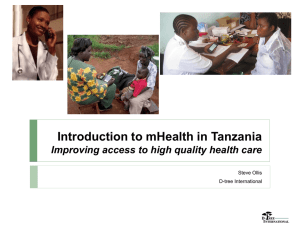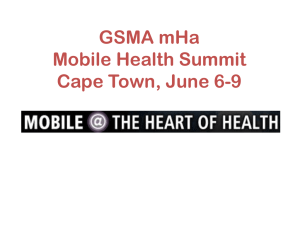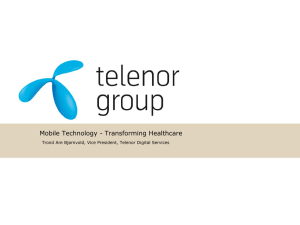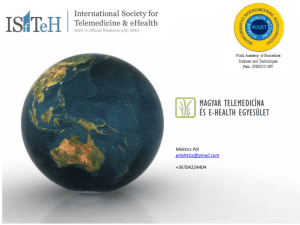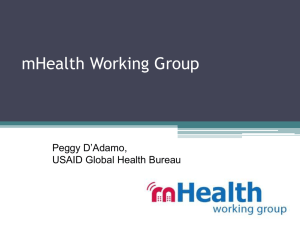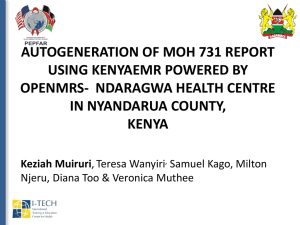View Session Handouts.
advertisement
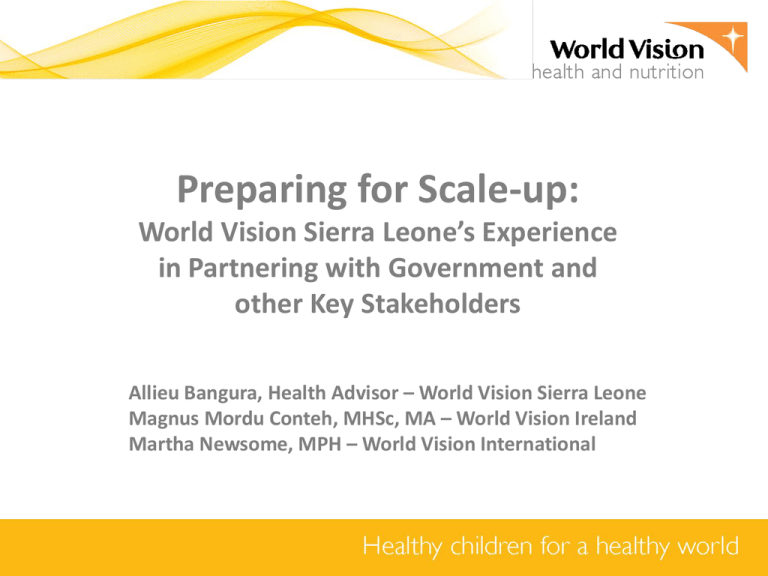
Preparing for Scale-up: World Vision Sierra Leone’s Experience in Partnering with Government and other Key Stakeholders Allieu Bangura, Health Advisor – World Vision Sierra Leone Magnus Mordu Conteh, MHSc, MA – World Vision Ireland Martha Newsome, MPH – World Vision International World Vision & Digital Health World Vision’s mHealth Portfolio Motech Deployments Live in 8 Countries: Sierra Leone, Uganda, Zambia, Tanzania, India, Afghanistan, Indonesia, & Sri Lanka Supporting Govt Deployments In 3 Countries: Kenya, Rwanda, Cambodia Motech Deployments in Planning for 7 Additional Countries: Mozambique, Burundi, Niger, Ghana, Pakistan, Mauritania, Jerusalem/West Bank/Gaza Irish AID funded Grant Goal: To improve child and maternal survival SCOPE & BENEFICIARIES • 5 countries: Sierra Leone, Mauritania, Kenya, Tanzania, Uganda • 75,250 Pregnant Women • 75,250 Children (aged 0 24 months) • 2000 (+) Community Health Workers Sierra Leone Programme Overview Project Name: Community Management Mobile and Health Data System Geographic Location: Mattru Jong, Bonthe, Bonthe District Project Timing: January 2012-December 2015 Health Programming Models: Timed and Targeted Counseling (ttC) Target Population: 22,000 households CHWs Utilizing Mobile Solution: 207 Community Members Reached: 17,192 Programme Model Local Level Advocacy (CVA) Environment Level Community Health Committees (COMM) Community Level Caregivers Community Health Worker programme (ttC) Health System Teachers Individual level Traditional Leaders Religious Leaders Social/Cultural Practices Policies Government-Led Consortium Timeline National mHealth Coordinating Committee Civil Society Partners Mobile Network Operator Government of Sierra Leone Telecommunications Regulator Ministry of Information & Communication WV’s pre-existing partnerships within Maternal and Child Health Government-Driven Digital Health • Fully aligned with national strategy and policy for development and health • Build tacit Government ownership and tangible support for national implementation • Focus early on health information policy framework • Ensure that telecommunications regulatory frameworks and environments are conducive to multi-stakeholder and private sector contribution • Commit to bringing different groups “to the table” consistently over time • Identify and leverage the talent and resources of different partners • Help create an environment of mutual transparency & build working relationships over time Mobile for Ebola • WV is planning to train and equip CHWs for contact tracing and community surveillance using a mHealth application • IFRC has sent about 2 million messages a month, advising citizens how to avoid getting infected and to seek immediate treatment if they do http://www.reuters.com/article/2014/11/05/healthebola-leone-mobilephone-idUSL6N0SU4JC20141105 • Alongside Sierra Leone’s Open Government Initiative (OGI), Airtel & Cambridge University, IBM has implemented a system to enable citizen reporting of Ebola through both SMS and voice. • UNFPA, WHO, MoH – has trained and equipped 300+ contact tracers with phones for tracing and surveillance. • http://www.chwcentral.org/blog/community-healthworkers-respond-ebola-outbreak-sierra-leone Key Partners and Collaborators Thank You! MHealth Monitoring: Insights from practice in West-Africa François Laureys, IICD Global mHealth Forum 2014 IICD in sector Health Mali and Senegal & malaria o WHO health system ranking: 163rd (Mali) and 59th place (Senegal) INFO-STAT/CPS, Mali – Survey on Health and Demography Mali (EDSM-V), 2012-2013 o Malaria is on 3rd place of (fatal) illnesses in Mali and Senegal Child mortality & malaria: 98/1,000 (Mali) 65 /1,000 (Senegal) Overall death & malaria: 42/100,000 (Senegal) 69.4/100,000 (Mali) o Small budget, huge shortage of (professional) health staff o Children & treatment < 24 hours: 22.5% (Mali) 15% (Senegal) Ma Santé project 2011/2014 o Yirimandjio (Mali) 100,000 and Fatick (Senegal) 265,000 inhab. o (Child) health monitoring through use of 300 Community Health Workers (CHWs) o Focus on malaria (and child health) mHealth intervention supports: Data collection and analysis Communication Case-management and referral Disease surveillance How does it work? Results 2011-2014 Mali o 100,000 – 150,000 people reached o 20% increase in children receiving treatment < 24 hrs o 85% CHWs use mobile app o 74% women sleep under treated bed net o 65% pregnant women take medication Health outcome level o 31% decrease of malaria symptoms among pregnant women o 35% decrease of malaria symptoms among children < 5 years Partners Muso Ladamunen & RAES o Local implementation o Health expertise o Training and monitoring of CHWs o Community engagement o Lobby & advocacy Orange o Platform: Emerginov o Support software development in Senegal, technical advice in Mali o Support local lobby o Access to new funders (PPP) o Scaling potential (marketing) IICD o Project coordination o Technical capacity building o Coaching and advice o Partnership brokering & alignment o Facilitation of knowledge sharing o Monitoring & evaluation o Lobby & advocacy (international) Different approaches o Involvement national authorities vs local authorities o Driven by ‘mutuelles’ vs communities o Locally developed software vs operator driven development Engagement Policy making Ownership Sustainability Conclusion: multistakeholder partnership strategy o National authority involvement is capital, but requires ‘leverage’ o Community involvement is key for sustainability o Private sector involvement contributes to standardization and quality norms o Disengagement from private sector can occur if investments / revenues are out of balance o Catch 22 for software development – local vs international, quick wins vs long haul, lowcost vs ‘international pricing’ o Partnership brokering and management is essential Resources at iicd.org ICT in Health: 5 Years of learning (IICD 2013) ICT- A Genuine Tool to reduce isolation and raise Health Awareness (IICD 2011) Multimedia Centres for Health workers in Ghana (IICD 2011) Connecting medical specialists in Rural Hospitals through ICT (IICD 2010) Health Management Information Systems for Hospitals (IICD 2010) Digital Hygiene Education and Multimedia (IICD 2010) ICTs and Continuing Medical Education in East Africa (IICD 2009) Thank you! Flaureys@iicd.org www.iicd.org Facebook.com/iicd.org #IICD December 10-11, 2014 Adoption and Scale-up of an mHealth Initiative to enhance Early Infant Diagnosis (EID) of HIV in Zambia Presentation by: Kaluba K. Mataka mHealth Project Manager, Zambia Center for Applied Health Research and Development (ZCAHRD) Background • The Human Immunodeficiency Virus (HIV) prevalence in Zambia estimated at 14.3% • 21% of HIV infections result from Mother-to-child transmission (MTCT) • Antiretroviral (ART) therapies are used to prevent MTCT • However, EID is critical to support early initiation of ART in infants when prevention of MTCT fails • Dried blood spot (DBS) samples from infants are sent to a small number of regional laboratories to be tested for HIV with polymerase chain reaction (PCR) • Timely sample transportation and result delivery constitute a big challenges to developing an effective EID service in low resource settings Background (2) • Prior Turnaround Time (TAT) from sample collection to result delivery in 10 pilot sites was 66 days ref - Early Infant Diagnosis: System Summary (2008) – MoH & Clinton H/A Initiative • The Zambia Ministry of Health (MOH) and partners introduced Programme Mwana, an SMS-based text messaging system to send HIV infant test results directly from the 3 national testing laboratories to the distant health facility of origin within minutes instead of days Partners Identification • In 2008 CHAI, ZCAHRD and UNICEF began exploring measures to reduce lengthy HIV testing turnaround times: Meetings with MOH and identification of groups/persons at the ministry to spearhead this process Identify stakeholders in EID and implementers with expertise • CHAI (Clinton Health Access Initiative) • ZPCT II (Zambia Prevention Care and Treatment Partnership) • ZCAHRD (Zambia Center for Applied Health Research and Development) • UNICEF (United Nations Children’s fund) • MOH (Zambia Ministry of Health) Site and Facility selection for pilot phase based on partners identified Partners: Aligned Interest ZCAHRD UNICEF •PMTCT capacity for quick on-site implementation •Ability to conduct research and evaluations • RapidSMS experience + technical capacity • Funding CHAI • Conducted EID study in 2008 • Proposed usage of SMS printers MOH • Focus on EID program • Central control and support for mHealth intervention • Local ownership and direction Locations of Pilot Sites North-Western Province: • 2 Sites • Across 2 Districts • Implementer: CHAI & ZPCT II Copperbelt Province: • 3 Sites • Across 2 Districts • Implementer: CHAI & ZPCT II Luapula Province: • 11 Sites • Across 3 Districts • Implementer: UNICEF Northern Province: • 2 Sites • Across 1 District • Implementer: CHAI & ZPCT II Southern Province: • 10 sites • Across 2 Districts • Implementer: ZCAHRD Central Province: • 3 Site • Across 3 Districts • Implementer: CHAI & ZPCTII Programme Mwana • Built on RapidSMS©, an open source framework • System is free of charge to the end users and is available across the two major networks in the country • Programme Mwana main features: Results 160 • • • Designed for Health workers Delivers infant HIV lab results to Facilities via SMS Tracks samples through logistics system RemindMi • • • • Designed for Community health workers Patient follow up Patient tracing Birth registration Web Management Tool • • • • Manages Program Monitors compliance Full program statistics, reports, charts, alerts, message boards National, provincial, district and partner level From Pilot to scale MOH approved Pilot Proposal Onsite system development supported by UNICEF 2009 – 10 Launch of the Pilot phase (8 Months) Jul ‘10 – Feb ‘11 Evaluation & Dissemination meeting with MoH and Partners Recommendation to scale and National Launch May‘11 Nov ‘11 Publication of pilot evaluation (WHO bul.) Mar ‘12 * National Scale-up activities for Programme Mwana commenced in 2012 beginning with 200 sites Critical success factors Govt. Ownership • mHealth platform • Identification of key staff • Scale-up in non-partner supported sites Partnership • Implementation in partner’s supported sites • Coordination of efforts Govt. Leadership • Aligning mHealth as a strategic priority • Inclusion in ICT policies • Inclusion in 2015 activities (budget) • Involved in entire system process Enabling environment • Feedback and reporting • Inclusion in PMTCT, Pediatric/HIV TWGs; provincial, partner and district Data review meetings • Creation of mHealth TWGs Coordination • Provided through leadership of MOH & UNICEF Collaboration of development teams Collaboration with mobile service providers Creation of the mHealth TWG • Use of both international and local software developers • Provision of system on two major networks • To coordinate and oversee all mHealth activities Refinement of system • Based on lessons learnt from pilot and scale-up phases Standardization of training materials • Creation of national training materials based on lessons learnt Training of national master trainers Coordination of scale-up process • At partner and provincial level • Creation of national scale-up through mHealth TWG System Integration • • • • Adaptability System data System Usability System fit into already existing PMTCT and EID programs Translated into the 7 major languages Standardization of registers used Inclusion of mHealth in National eHealth strategy • Reports generated by system included in national review meetings • Users receive monthly aggregated reports • Use of data to inform the management and direction of the program • • • • Use of local developers Access databases located in DNA PCR testing labs System server based at MOH Ease and duration of trainings • No cost to end users • Simplicity of messages • Use of personal phones Sustainability • MOH endorsed national scale up to all PMTCT/EID sites in the country o Partners involved in the scale-up strategy development and adoption • MOH established the national mHealth TWG chaired by the ministry to oversee, manage and report back on the scale up process • Master trainers formed at provincial and district levels to cascade localized training and support • Scale up activities commenced in 2012 with 200 facilities targeted o Currently operating in > 730 facilities (52% coverage) across 10 provinces System Impact Scale-up activities conducted in facilities with and without mobile network access Availability of program data for implementers via the Mwana web tool at National, provincial, district and partner level Increase in DBS testing numbers from 4829 samples in 2010 to 11076 in 2012* Effective usage of the blast messaging feature for other health related issues (+7790 messages sent out) Transparency of data: https://mwana.moh.gov.zm Challenges “mHealth is by no means a panacea that will solve all of the challenges we face in the Health sector” Pilot Phase Scale-up Phase Difficulties in establishing leadership and ownership esp. at provincial and district levels due to small number of sites running the system (limited system impact) New structural reorganizations within the MOH leaving the mHealth TWG with no clear leadership Initial lack of confidence in the results sent via SMS especially with Clinical officers Partner commitment: different partners entails different scale-up approaches based on sites supported and funding Difficult collaboration with mobile phone providers Despite system being free to end users, contracts with mobile providers need to be serviced and sustained Limited number of staff at facility were trained and procured facility phones posed a challenge esp. phone charging and phone repairs challenges being experienced in sample courier processes, availability of DBS kits and Lab reagents as success of system dependent on these factors as well Dependence of mobile network availability and seamless internet service Next steps with mHealth in Zambia • MCDMCH (Ministry of Community Development Mother and Child Health) is scaling up Option B+ in Zambia and this offers up new creative and innovative way to use Mwana: o o o o Adherence Mentorship Community Patient follow up • Other possible system modules for inclusion o Disease Surveillance module o Stock module to address issues related to stock management • Working closely with the ministries to further enhance partnerships with the mobile providers o Bring on board 3rd mobile provider Thank You Contributors: Judith Nguimfack, Corrie Haley, Jill Berkowitz, Kebby Musokotwane & Donald Thea Funders: CDC, Bill & Melinda Gates Foundation, Johnson & Johnson, USAID, Global Fund Government through: MOH & MCDMCH Partners: UNICEF, CHAI, CHAZ, CIDRZ, ZCAHRD & ZPCTII Creating Scale Through Strong Partnerships: How It Is Done Presented by Marc Olsen, Co-Chairman mHealth Summit - December 2014 My Talking Points I. Why Partnerships Matter II. Formula to Find Partner Success III. Setting Your Filters IV. How to Find a Winning Combination V. What I’ve Learned – Final Takeaways Page 43 2014 mHealth Summit Why You Can’t Go It Alone Nuts & Bolts of Kilifi Kids: • • • • NGO operating in mHealth since 2009 Focus on ANC & immunizations; solution centers on health workers Multiple sites in Kenya with 500 CHWs & 11 C.U.s “Out-of-box” solution: Goal of 12 sites covering 1 million in next years Why Partnerships Are Important • • • • • Page 44 Jan 2013: Aug 2013: Oct 2013: Jan 2014: Ongoing: To Fix Problems: Project delays from national election Ministry turnover and problems with leadership gaps Hardware disappearance National strike by health workers Decentralization of national government 2014 mHealth Summit Formula for Partnerships Required Ingredients: To Create Scale: 1. Government 1. Industry 2. Funding 2. Suppliers 3. Technical 3. Research 4. Community 4. Collaborative Page 45 2014 mHealth Summit Setting Your Filters – Know Yourself Step #1 - Understand Your Gaps: 1. 2. 3. 4. Understand what state you are driving towards (need numbers) Determine your short fallings (KK: technology) Determine your commitment level (KK: research low initially) Create a timeline for your development Step #2 – Setting Criteria that is Right for You: Questions that we ask when evaluating potential partners for fit (besides normal due diligence on experience, track record, reputation, etc): 1. 2. 3. 4. 5. Page 46 Can they fill a specific or strategic gap of mine? (Ex: sustainability) Where do our mutual interests lie? What will the cost be for all parties? What is needed to build trust? Does this benefit the people I want to help? (Ex: private bank) 2014 mHealth Summit Assessing Fit – Much Like Investing Identification - Find Partners Who Share Your Vision: 1. 2. 3. Can never talk to too many people, but don’t waste others’ time Look for partners in unusual places (personal network is underrated) Create a culture where every team member is a partner-maker Process - Treat It like a Business: 1. 2. 3. 4. Page 47 Shop around— Recognize that most will not advance through your filters Set costs for all parties to ensure buy-in Negotiate clear terms and create MOU, even if strong trust already exists Evaluate regularly if worth continual investment 2014 mHealth Summit Assessing Fit – Much Like Investing (2) Manage Expectations: 1. 2. 3. Can’t over communicate to core partners; need to spell out type and frequency Regular reporting is not a choice; accountability of each actor keeps project on track Transparency is necessary and easier than ever (Ex: finances) Scale Quickly: 1. 2. Page 48 Thinking big is a requirement; all partners must agree to growth Once model is proven & trust built with the right partners, seek to expand ferociously 2014 mHealth Summit What I’ve Learned 1. Make sure you have all your bases covered – Fill gaps with partners who can spread risk and bring resources (Never stop looking; “stock your bench full”) 2. Document everything – It doesn’t exist if not written down; Minimum: (1) internal selection criteria and (2) MOU 3. Be patient – Great partners are worth the wait (sometimes years) 4. Keep tomorrow in mind – Set game plan for partner growth Page 49 2014 mHealth Summit Thanks for your time! More Questions: marc.olsen@kilifikids.org
